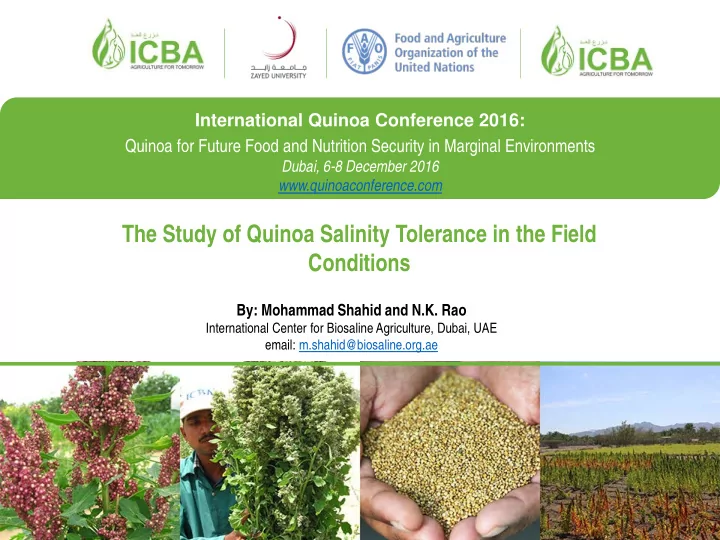

International Quinoa Conference 2016: Quinoa for Future Food and Nutrition Security in Marginal Environments Dubai, 6-8 December 2016 www.quinoaconference.com The Study of Quinoa Salinity Tolerance in the Field Conditions By: Mohammad Shahid and N.K. Rao International Center for Biosaline Agriculture, Dubai, UAE email: m.shahid@biosaline.org.ae
UAE geography situated in south eastern corner of the Arabian Peninsula a relatively small country with an area of 83, 600 square km most of the country is desert which is part of a vast sea of sand called Rub’ al Khali or Empty Quarter
Agricultural problems in the UAE Limited cultivated land Most of the country is comprised of desert Small area for agriculture farming is available. Fewer water resources Annual rain is less than 120mm (4.7 inch) in most of the areas Most of the ground water is brackish, which is not suitable for majority of crops
Challenges To find crops which can be grown in such harsh environments with limited amount of fresh water Apart from other crops, QUINOA was tried in the United Arab Emirates to see its potential as food and feed Evaluation of the performance of selected genotypes of quinoa for their productivity on different qualities of irrigation water.
Exper perimental Si Site Experimental site • The experiment was conducted at the International Center for Biosaline Agriculture (ICBA), Dubai, United Arab Emirates • 25°05.794 N • 055°23.386 E
Soi Soil T Type Soil type • The soils at ICBA experimental fields are sandy in texture, that is, fine sand (sand 98%, silt 1%, and clay 1%) • Calcareous (50–60% CaCO3 equivalents) • Moderately alkaline (pH 8.22). • Saturation percentage of the soil is 26 and has very high drainage capacity • Electrical conductivity of its saturated extract (ECe) is 1.2 dS m − 1 .
Accessions S.N. Accessions S.N. Accessions 1 11 ICBA-Q1 Salcedo Inia 2 12 ICBA-Q2 Blanca Junin 3 13 ICBA-Q3 Amarilla Marangani 4 14 ICBA-Q4 L 11 5 15 ICBA-Q5 L 119 6 16 NSL 86649 L 123 7 17 Ames 13749 L 142 8 18 Ames 13757 L 143 9 19 Ames 22155 Puno 10 20 Inia 415 Pasankalla Titicaca
Planting Planting Each set of accessions was sown in randomized complete block design (RCBD) in three replications Two water treatments (0 dS/m and 15 dS/m) Plot size was 2.5 x 2 m The seeds were sown manually by dibbling 3-4 seeds into the soil to a depth of 1-2 cm close to the dripper After sowing, field was covered with Acryl sheet
Irrigation Irrigation • A drip irrigation system was used • with a spacing of 50 cm between the laterals • 25 cm between the emitters has been installed in all of the experimental farms. • water was applied for 15 min @ 4 L/h
Fertilizers Fertilizers • Organic manure was applied before planting @ 40 tons/ha • Urea (46%) @ 30 kg/ha • NPK @ 30 kg/ha
Study Study The growth performance and yield potential of the 20 quinoa accessions was evaluated based on the study of different characteristics including
Plant Height Plant height
Number of primary branches per plant Number of primary branches per plant
Number of inflorescences per plant Number of inflorescences per plant
Inflores escence l e leng ength Inflorescence length
Yi Yield Yield
1,000 g grain w weight 1,000 seed weight
Concentration of K and Na in seeds
Plant hei height Plant height 120.0 100.0 80.0 Plant height (cm) 60.0 40.0 20.0 0.0 non-saline saline
Number of r of branches p per er plan ant Number of branches per plant 12.0 10.0 8.0 6.0 4.0 2.0 0.0 non-saline saline
Numbe ber o of inflores escenc ences es p per p plant Number of inflorescence per plant 8.0 7.0 6.0 5.0 4.0 3.0 2.0 1.0 0.0 non-saline saline
Inflores escence l e leng ength Inflorescence length 35.0 30.0 25.0 Inflorescence length (cm) 20.0 15.0 10.0 5.0 0.0 non-saline saline
m 2 Seed y Seed yiel eld per per m Seed yield per m 2 160.0 140.0 120.0 100.0 seed yild/m 2 (g) 80.0 60.0 40.0 20.0 0.0 non-saline saline
1, 1,000 s 000 seed w weigh ght 1,000 seed weights 2.5 2.0 1000 seed weight (g) 1.5 1.0 0.5 0.0 non-saline saline
Na concentration in seeds 400.00 350.00 300.00 250.00 µg/50mg 200.00 150.00 100.00 50.00 0.00 ICBA-Q1 ICBA-Q2 ICBA-Q3 ICBA-Q4 ICBA-Q5 NSL 86649 Ames 13749 Ames 13757 Ames 22155 Puno Titicaca Non-saline Saline
K concentration in seeds 900.00 800.00 700.00 600.00 µg/50mg 500.00 400.00 300.00 200.00 100.00 0.00 ICBA-Q1 ICBA-Q2 ICBA-Q3 ICBA-Q4 ICBA-Q5 Ames 13749 Ames 13757 Ames 22155 NSL 86649 Puno Titicaca Non-saline Saline
Conclusions • Five of the quinoa lines (ICBA-Q1…Q5) developed at ICBA performed better than the other accessions. • Their performance was superior both at low and high salinity • These lines have the potential to be grown in the similar type of regions with saline water of up 15 dS/m • Salinity treatment increases the Na concentration in the quinoa seeds up to 400%
Thanks
Recommend
More recommend